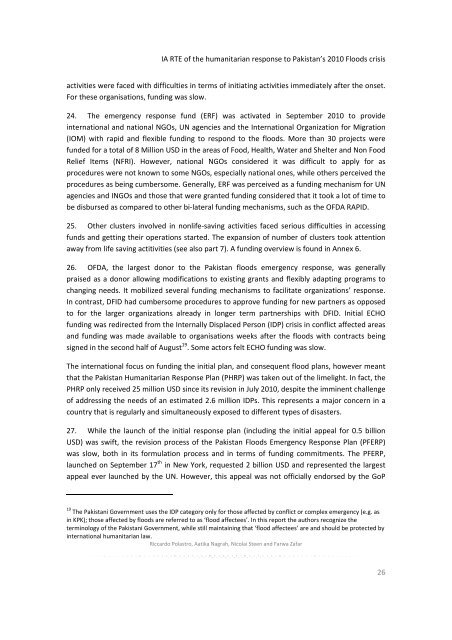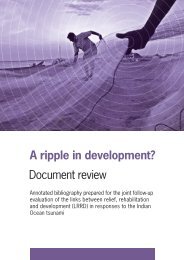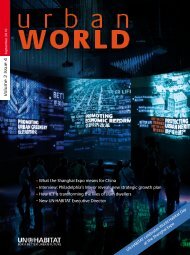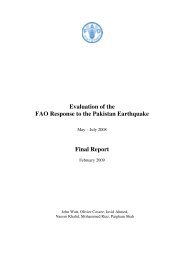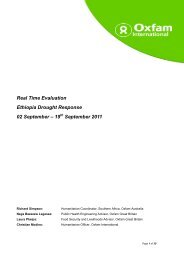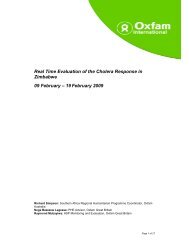Inter-Agency Real Time Evaluation of the Humanitarian ... - alnap
Inter-Agency Real Time Evaluation of the Humanitarian ... - alnap
Inter-Agency Real Time Evaluation of the Humanitarian ... - alnap
Create successful ePaper yourself
Turn your PDF publications into a flip-book with our unique Google optimized e-Paper software.
IA RTE <strong>of</strong> <strong>the</strong> humanitarian response to Pakistan’s 2010 Floods crisis<br />
activities were faced with difficulties in terms <strong>of</strong> initiating activities immediately after <strong>the</strong> onset.<br />
For <strong>the</strong>se organisations, funding was slow.<br />
24. The emergency response fund (ERF) was activated in September 2010 to provide<br />
international and national NGOs, UN agencies and <strong>the</strong> <strong>Inter</strong>national Organization for Migration<br />
(IOM) with rapid and flexible funding to respond to <strong>the</strong> floods. More than 30 projects were<br />
funded for a total <strong>of</strong> 8 Million USD in <strong>the</strong> areas <strong>of</strong> Food, Health, Water and Shelter and Non Food<br />
Relief Items (NFRI). However, national NGOs considered it was difficult to apply for as<br />
procedures were not known to some NGOs, especially national ones, while o<strong>the</strong>rs perceived <strong>the</strong><br />
procedures as being cumbersome. Generally, ERF was perceived as a funding mechanism for UN<br />
agencies and INGOs and those that were granted funding considered that it took a lot <strong>of</strong> time to<br />
be disbursed as compared to o<strong>the</strong>r bi‐lateral funding mechanisms, such as <strong>the</strong> OFDA RAPID.<br />
25. O<strong>the</strong>r clusters involved in nonlife‐saving activities faced serious difficulties in accessing<br />
funds and getting <strong>the</strong>ir operations started. The expansion <strong>of</strong> number <strong>of</strong> clusters took attention<br />
away from life saving actitivities (see also part 7). A funding overview is found in Annex 6.<br />
26. OFDA, <strong>the</strong> largest donor to <strong>the</strong> Pakistan floods emergency response, was generally<br />
praised as a donor allowing modifications to existing grants and flexibly adapting programs to<br />
changing needs. It mobilized several funding mechanisms to facilitate organizations’ response.<br />
In contrast, DFID had cumbersome procedures to approve funding for new partners as opposed<br />
to for <strong>the</strong> larger organizations already in longer term partnerships with DFID. Initial ECHO<br />
funding was redirected from <strong>the</strong> <strong>Inter</strong>nally Displaced Person (IDP) crisis in conflict affected areas<br />
and funding was made available to organisations weeks after <strong>the</strong> floods with contracts being<br />
signed in <strong>the</strong> second half <strong>of</strong> August 19 . Some actors felt ECHO funding was slow.<br />
The international focus on funding <strong>the</strong> initial plan, and consequent flood plans, however meant<br />
that <strong>the</strong> Pakistan <strong>Humanitarian</strong> Response Plan (PHRP) was taken out <strong>of</strong> <strong>the</strong> limelight. In fact, <strong>the</strong><br />
PHRP only received 25 million USD since its revision in July 2010, despite <strong>the</strong> imminent challenge<br />
<strong>of</strong> addressing <strong>the</strong> needs <strong>of</strong> an estimated 2.6 million IDPs. This represents a major concern in a<br />
country that is regularly and simultaneously exposed to different types <strong>of</strong> disasters.<br />
27. While <strong>the</strong> launch <strong>of</strong> <strong>the</strong> initial response plan (including <strong>the</strong> initial appeal for 0.5 billion<br />
USD) was swift, <strong>the</strong> revision process <strong>of</strong> <strong>the</strong> Pakistan Floods Emergency Response Plan (PFERP)<br />
was slow, both in its formulation process and in terms <strong>of</strong> funding commitments. The PFERP,<br />
launched on September 17 th in New York, requested 2 billion USD and represented <strong>the</strong> largest<br />
appeal ever launched by <strong>the</strong> UN. However, this appeal was not <strong>of</strong>ficially endorsed by <strong>the</strong> GoP<br />
19<br />
The Pakistani Government uses <strong>the</strong> IDP category only for those affected by conflict or complex emergency (e.g. as<br />
in KPK); those affected by floods are referred to as ‘flood affectees’. In this report <strong>the</strong> authors recognize <strong>the</strong><br />
terminology <strong>of</strong> <strong>the</strong> Pakistani Government, while still maintaining that ‘flood affectees’ are and should be protected by<br />
international humanitarian law.<br />
Riccardo Polastro, Aatika Nagrah, Nicolai Steen and Farwa Zafar<br />
26


